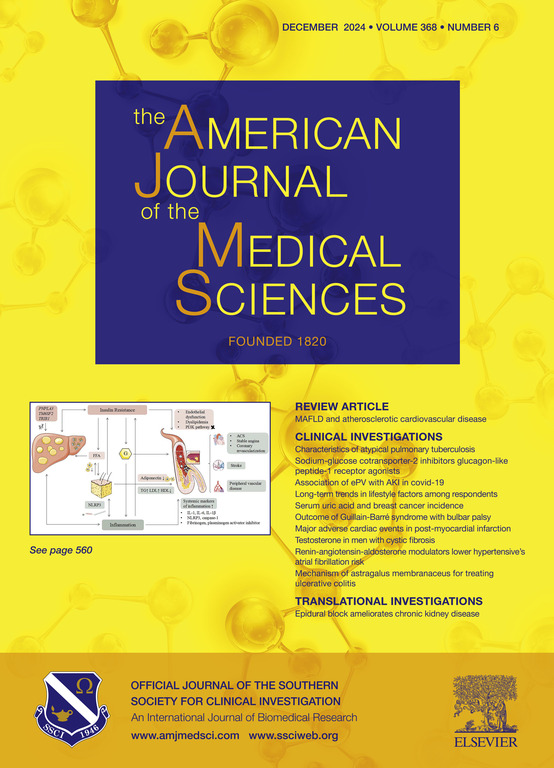Impact of inhaler treatments on respiratory functions and exacerbation frequency in non-cystic fibrosis bronchiectasis
IF 1.8
4区 医学
Q2 MEDICINE, GENERAL & INTERNAL
引用次数: 0
Abstract
Background
Bronchiectasis is a chronic airway disease caused by abnormal and permanent dilation of the airways. This study aimed to evaluate the effects of inhaler therapy use on respiratory functions and clinical outcomes in patients with non-cystic fibrosis bronchiectasis.
Methods
One hundred forty-six patients with non-cystic fibrosis bronchiectasis aged over 18 years, diagnosed using high-resolution computed tomography, were included in the study. Age, sex, body mass index, smoking status, additional diseases, known etiologic factors, and vaccination status of the patients included in the retrospectively designed study were recorded as sociodemographic data. Respiratory functions, disease severity, and clinical outcomes of patients with bronchiectasis who did and did not receive inhaled anticholinergic and steroid treatments were compared.
Results
Ninety (61.6 %) of the 146 patients included in the study were women. The mean age was 56.14 ± 16.22 years. The etiology of bronchiectasis was unknown in 78 (53.4 %) patients. The most prevalent comorbidity was asthma. According to modified Reiff scoring, 91 (62.3 %) patients were classified as having mild bronchiectasis. Twenty-six (17.8 %) patients had airway obstruction. There were 93 (63.7 %) patients using inhaled corticosteroids and 32 (21.9 %) using inhaled anticholinergics.
Conclusions
It was determined that patients using inhaler anticholinergics or inhaled steroids were in the more severe group. However, inhaler anticholinergic and inhaler steroid treatments had no effect on hospital admissions and exacerbation frequency in patients with bronchiectasis. Hospitalizations were more frequent among patients with bronchiectasis using inhaled steroids.
吸入器治疗对非囊性纤维化支气管扩张呼吸功能和加重频率的影响。
背景:支气管扩张是一种由气道异常和永久性扩张引起的慢性气道疾病。本研究旨在评估吸入器治疗对非囊性纤维化支气管扩张患者呼吸功能和临床结局的影响。方法:146例18岁以上的非囊性纤维化支气管扩张患者,采用高分辨率计算机断层扫描诊断。回顾性设计研究中纳入的患者的年龄、性别、体重指数、吸烟状况、其他疾病、已知病因和疫苗接种情况被记录为社会人口学数据。比较了接受和未接受吸入抗胆碱能和类固醇治疗的支气管扩张患者的呼吸功能、疾病严重程度和临床结果。结果:纳入研究的146例患者中有90例(61.6%)为女性。平均年龄56.14±16.22岁。78例(53.4%)患者支气管扩张病因不明。最普遍的合并症是哮喘。根据改良的Reiff评分,91例(62.3%)患者被归为轻度支气管扩张。26例(17.8%)患者出现气道阻塞。吸入糖皮质激素患者93例(63.7%),吸入抗胆碱能药物患者32例(21.9%)。结论:使用吸入式抗胆碱能药物或吸入式类固醇药物的患者属于较严重组。然而,吸入器抗胆碱能和吸入器类固醇治疗对支气管扩张患者的住院率和加重频率没有影响。吸入类固醇治疗支气管扩张患者的住院率更高。
本文章由计算机程序翻译,如有差异,请以英文原文为准。
求助全文
约1分钟内获得全文
求助全文
来源期刊
CiteScore
4.40
自引率
0.00%
发文量
303
审稿时长
1.5 months
期刊介绍:
The American Journal of The Medical Sciences (AJMS), founded in 1820, is the 2nd oldest medical journal in the United States. The AJMS is the official journal of the Southern Society for Clinical Investigation (SSCI). The SSCI is dedicated to the advancement of medical research and the exchange of knowledge, information and ideas. Its members are committed to mentoring future generations of medical investigators and promoting careers in academic medicine. The AJMS publishes, on a monthly basis, peer-reviewed articles in the field of internal medicine and its subspecialties, which include:
Original clinical and basic science investigations
Review articles
Online Images in the Medical Sciences
Special Features Include:
Patient-Centered Focused Reviews
History of Medicine
The Science of Medical Education.

 求助内容:
求助内容: 应助结果提醒方式:
应助结果提醒方式:


